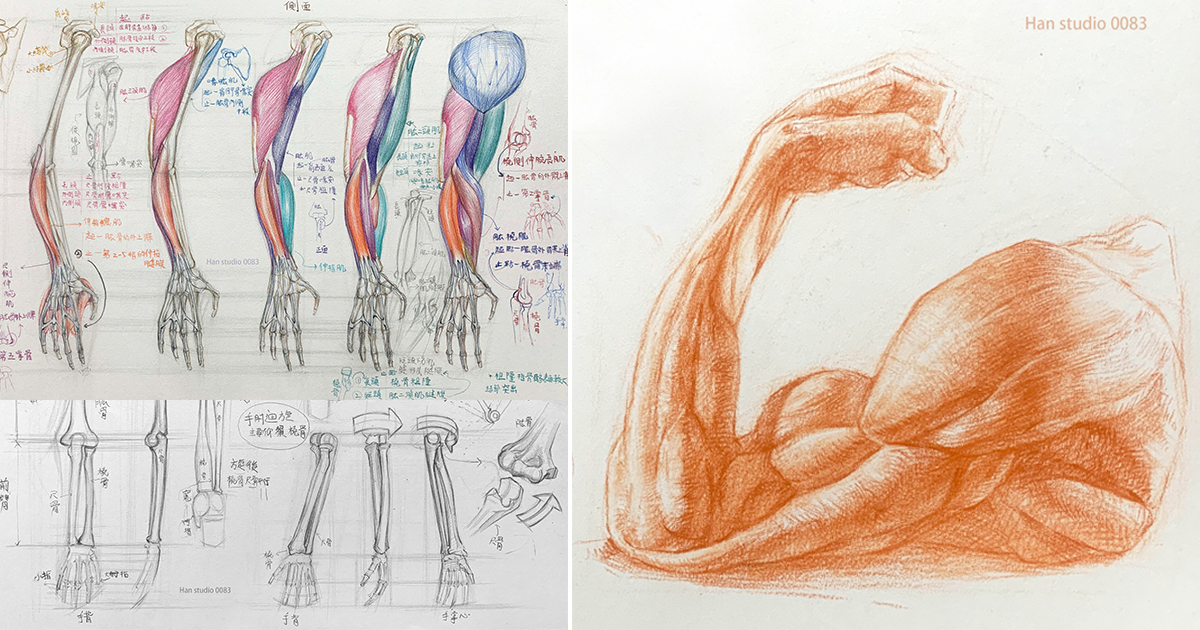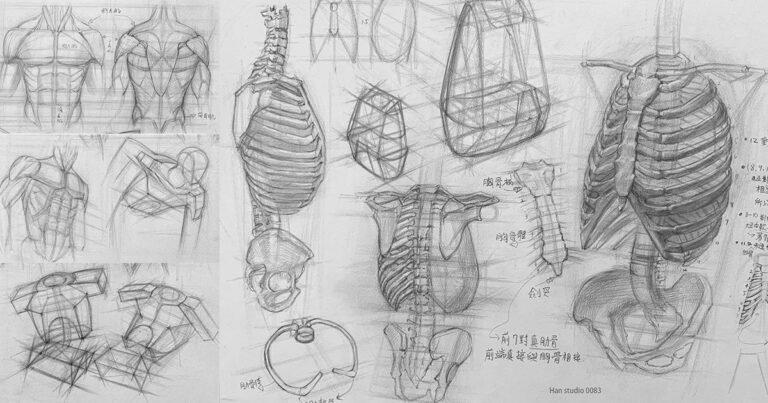This Week’s Plaster Study: Exploring Arm Structure
This week’s plaster study features a girl’s bust with a resting chin pose. Bright objects are so tempting to overwork! Compared to previous plaster studies, this one offered more room for variation in the hair. 🙋
As I worked on the pose, I took the opportunity to delve into the arm structure. Let’s dive in!
Why Study the Arm’s Bone and Muscle Structure?
- Visual Persuasiveness: Accurate muscle form makes figure poses feel more dynamic and structured.
- Motion Clarity: Understanding the relationship between flexors and extensors helps in drawing natural elbow bends and arm extensions.
- Lighting and Shading: Knowing how muscle masses correspond to light and shadow helps locate the transition points of volume structure.
1. The Composition and Functional Structure of the Arm Bones:
Scapula Position:
In the demo, you can see the outline of the scapula marked with lines, including the acromion and coracoid process.


●Upper Arm – Humerus
Location: The only bone in the upper arm, connecting the shoulder joint to the elbow joint.
Key Features:
The upper end has a rounded ball-like shape that connects to the shoulder. The lower end forms the elbow joint by connecting with the radius and ulna.
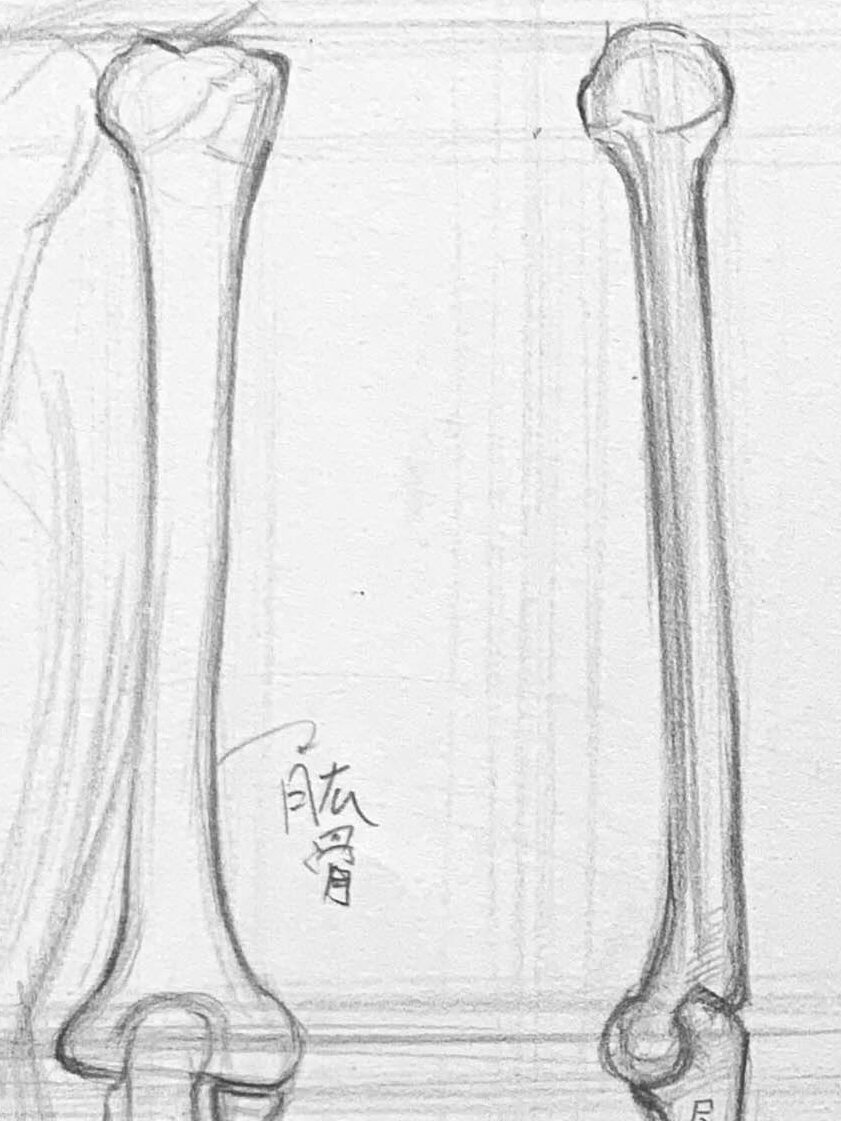
Forearm – Radius and Ulna
These bones are responsible for supporting the arm and enabling rotational movements.
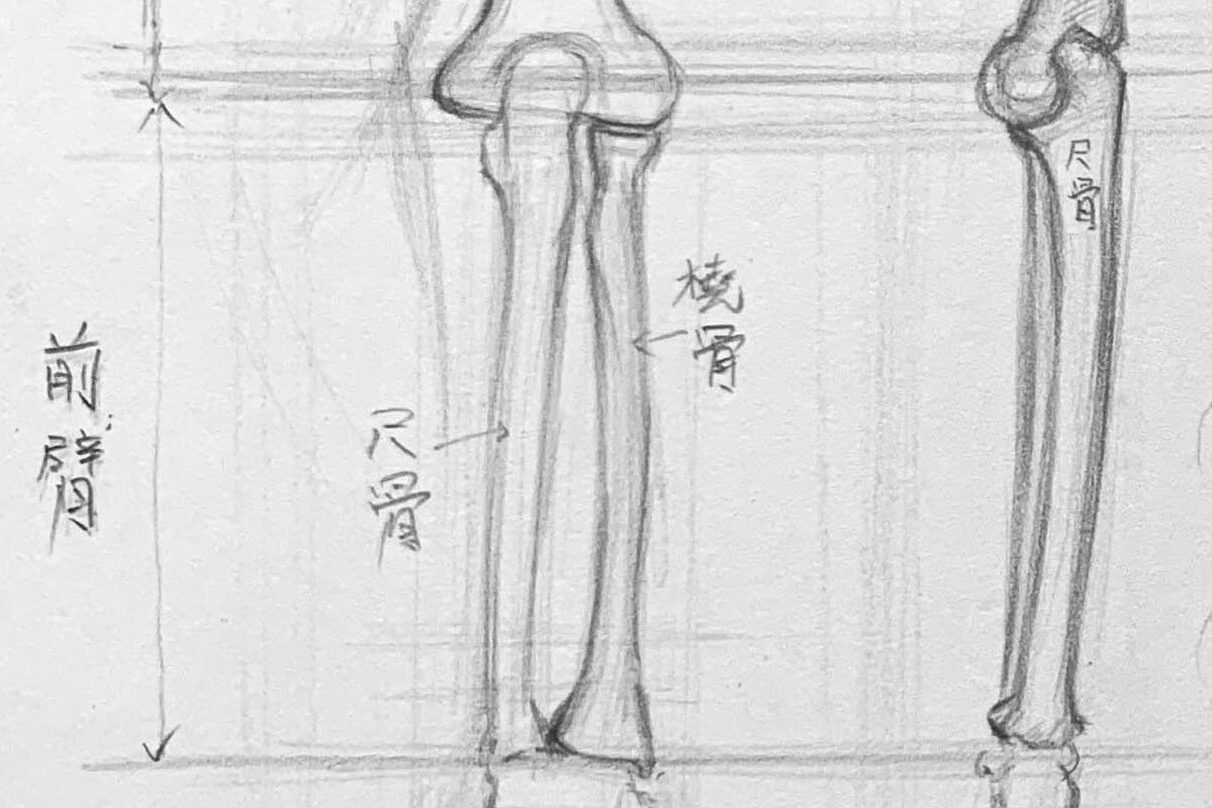
●Radius:
Location: On the thumb side.Smaller at the upper end (near the elbow joint) and broader at the lower end (near the wrist joint).
Function: Responsible for movement during forearm rotation (pronation and supination)


●Ulna:
Function: Provides stability and serves as the primary supporting bone of the elbow joint.
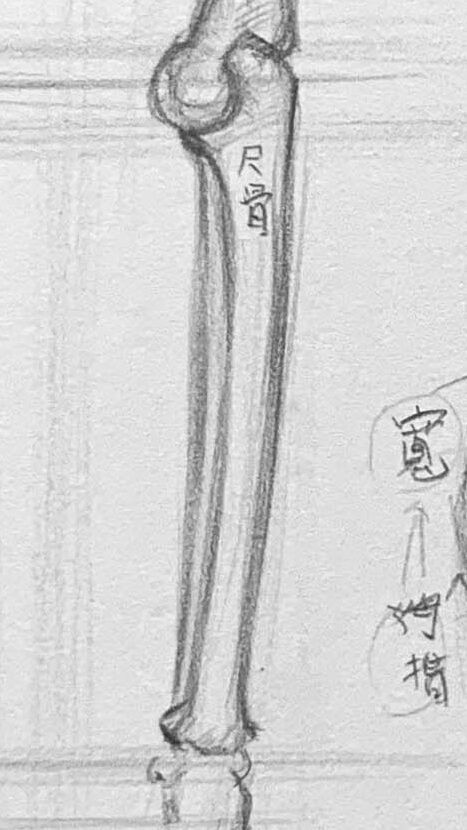

2. Arm Movements and Joint Mechanisms
●The Elbow Joint: Formed by the humerus, radius, and ulna.
Our arm movements include bending, straightening, and rotating. Rotational movements
Rotational movements, such as writing, riding a bike, or typing, are particularly frequent in daily life. But what allows us to make these movements?
●Characteristics of arm bone movement:
- 1.Bending and Straightening: Centered around the elbow joint, with the ulna providing stability and the radius enabling mobility. The small diagram on the far right illustrates how the elbow joint flexes and extends, resembling a C-shaped groove.
The elbow joint is a hinge-type joint primarily responsible for the flexion and extension of the forearm relative to the upper arm.
- Flexion: When the forearm bends upward, the elbow joint reduces the angle between the humerus and the forearm, such as when lifting heavy objects or picking something up.
- Extension: When the forearm straightens downward, the elbow joint opens up, forming a near-straight arm posture, such as in the motion of pushing against a wall.
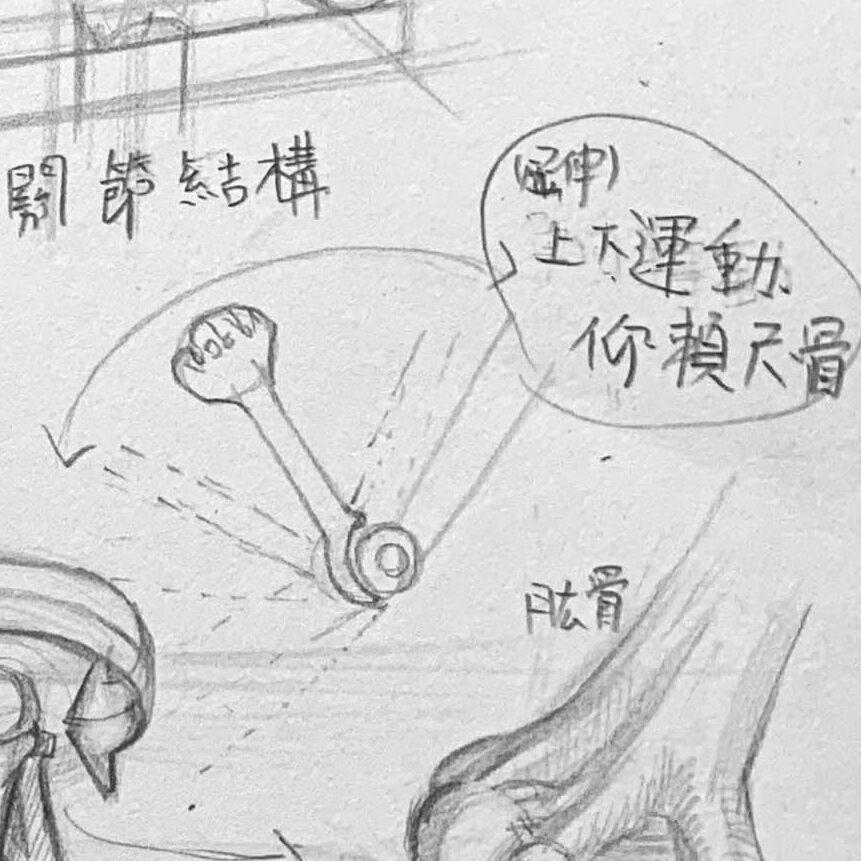
The small diagram below illustrates the movement of the elbow joint, with the joint shaped like a C-shaped groove.
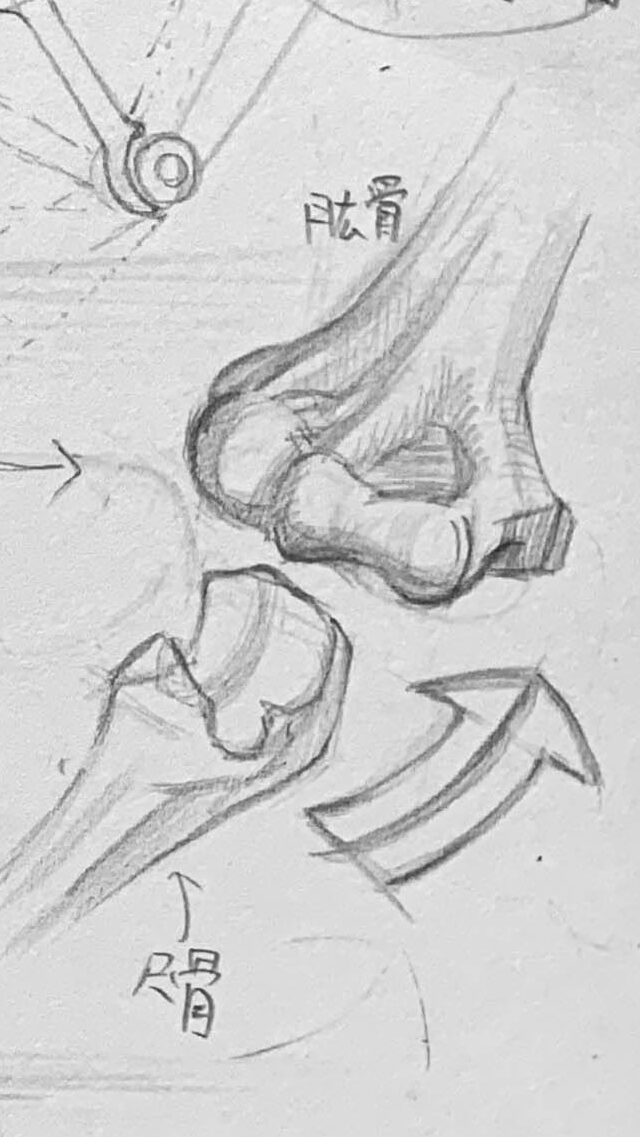
The way our elbow flexes and extends is similar to a cylinder rotating within a groove.
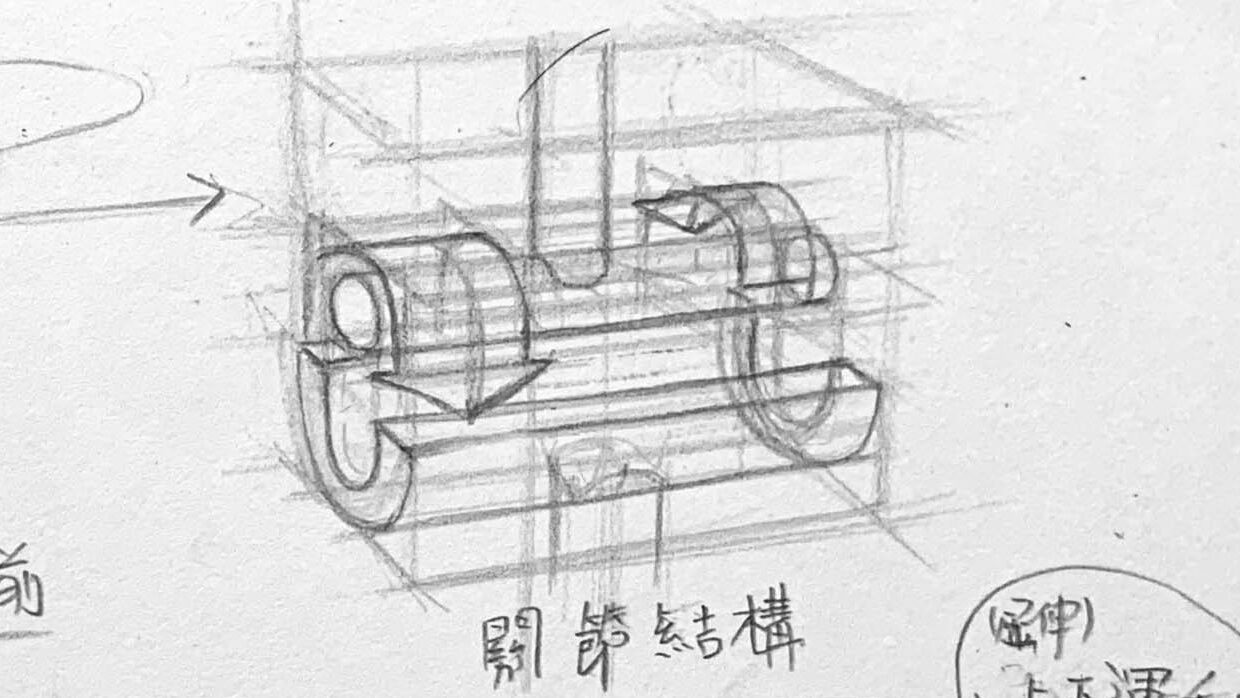
- Pronation and Supination: When the palm rotates, the radius rotates around the ulna (see the middle diagram). The radius overlaps the ulna during rotation, creating an X-like shape.
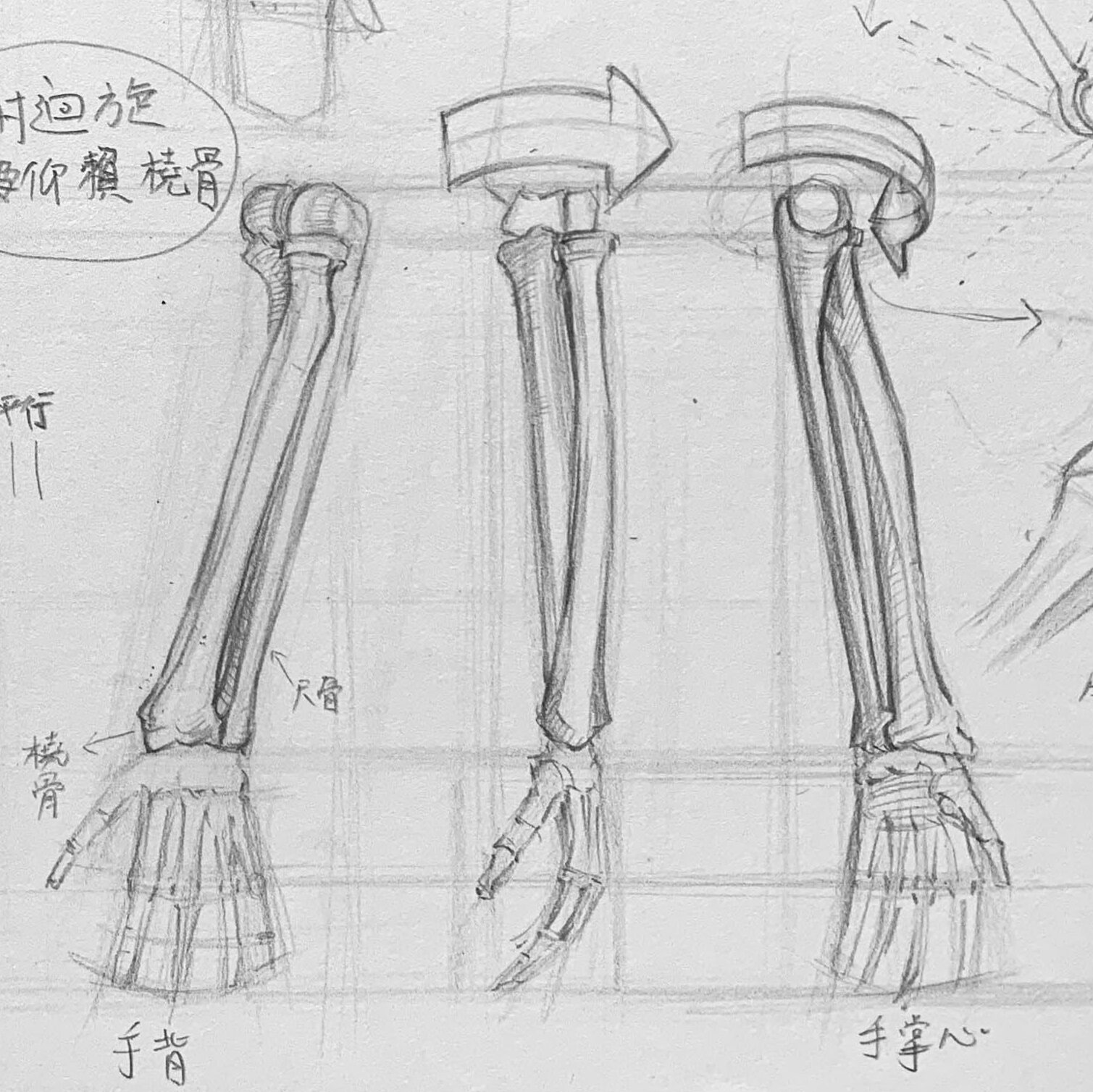
- Pronation: When the palm faces downward, the radius rotates and crosses over the ulna, with the palm facing down. For example, placing your palm flat on a table demonstrates pronation.
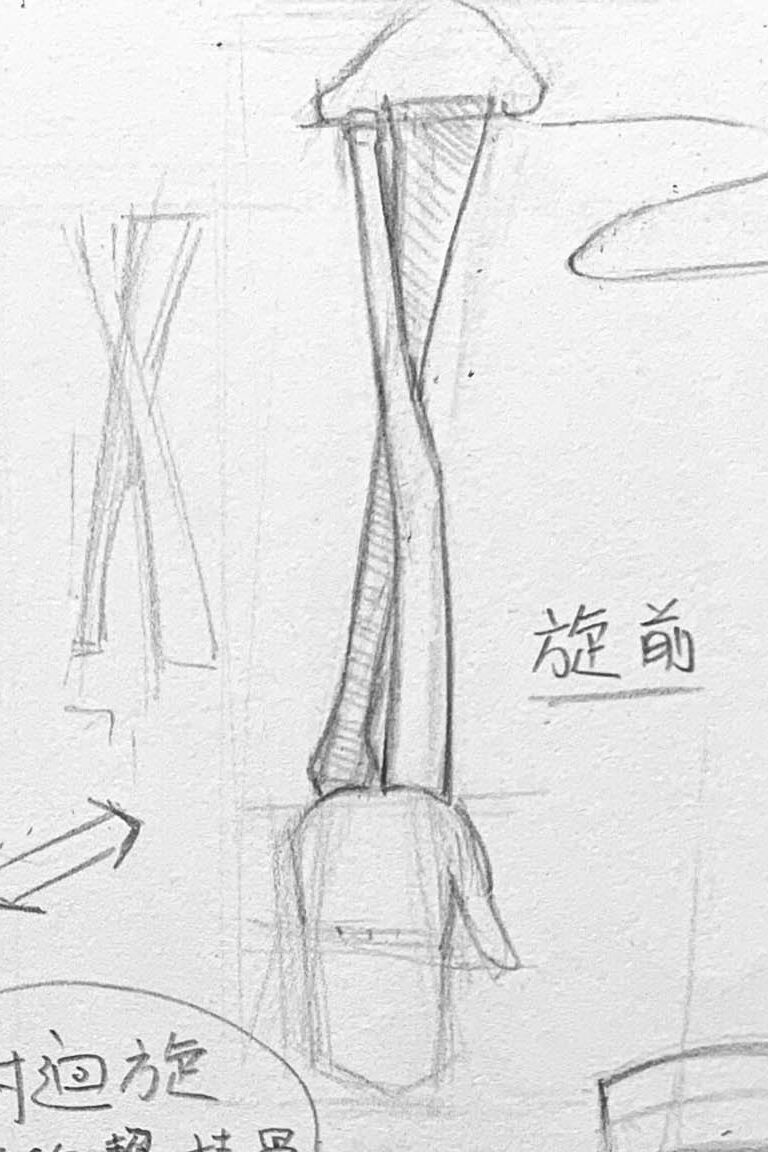
- Supination: When the palm faces upward, the radius and ulna align parallel to each other, allowing the palm to face up. For instance, opening your palm to catch something is an example of supination.

3.Simplifying Bone Shapes:
To better understand their features, bones can be simplified into geometric forms. Refer to the middle diagram for simplified shapes.
●Humerus:
Resembles a cylinder with varying thickness, wider at both ends and narrowing in the middle.
●Radius and Ulna:
The radius is broader near the wrist, while the ulna is wider near the elbow.
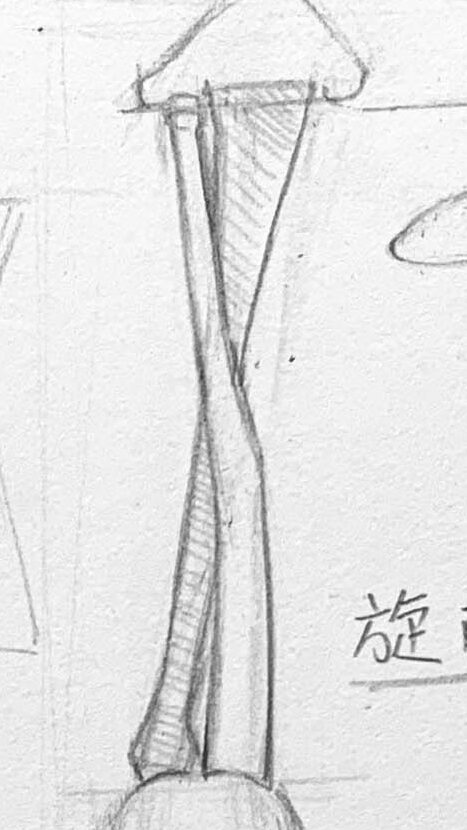
● Understanding the major muscle groups of the arm
First, let’s take a look at several key muscles in the arm. These muscles affect both the shape and strength of the arm.
We’ll begin by establishing a learning order: "bones → muscles → movement". Understanding the structure from the inside out makes it easier to grasp how muscles twist and shift when drawing action poses.
- Every muscle must originate from one bone and insert into another.
That’s why it’s important to first understand the placement of the bones. For example, you need to know where the humerus is in order to understand how the biceps and triceps pull or stretch around it.
Shoulder and Outer Upper Arm Muscle Group
Deltoid:
The overall shape of the shoulder is formed by the deltoid.It resembles an inverted water droplet or trapezoidal cap, sitting on top of the shoulder and playing a key role in creating its round, muscular appearance.
- Origin: Outer end of the clavicle, acromion, and spine of the scapula
- Insertion: Lateral middle part of the humerus (deltoid tuberosity)
- Demo Image: The blue mesh area on the far right represents the coverage of the deltoid.
- Function: Raises the arm. The deltoid acts like a “bridge” stretching across the shoulder and outer upper arm.

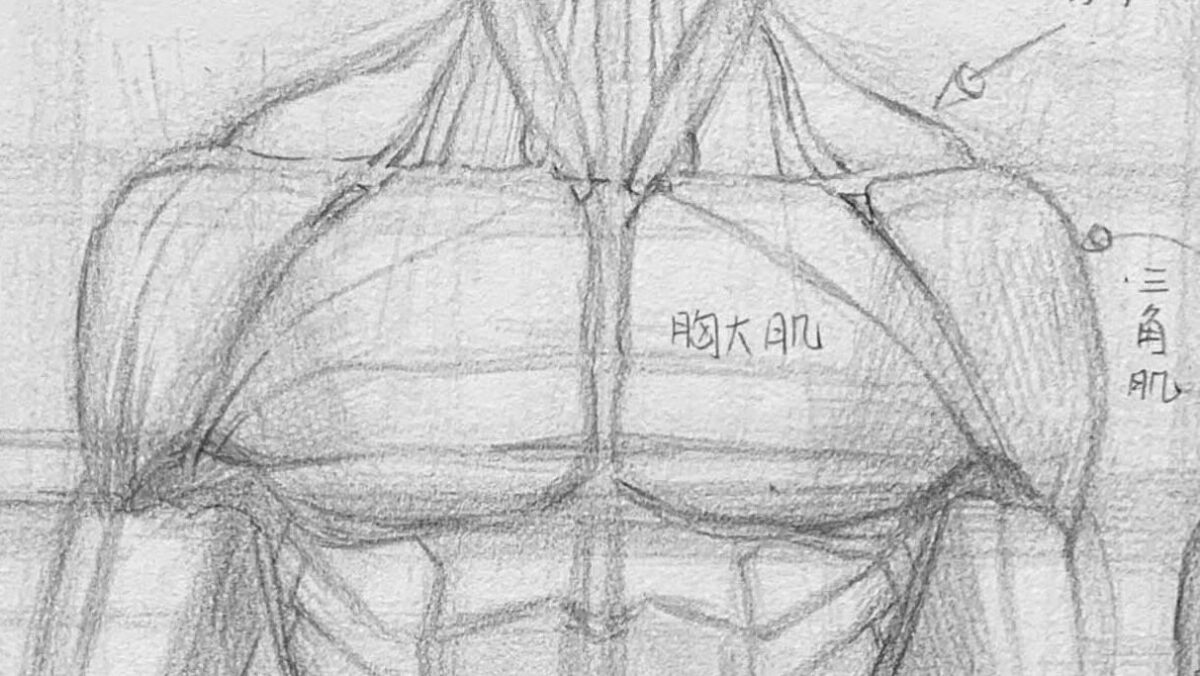
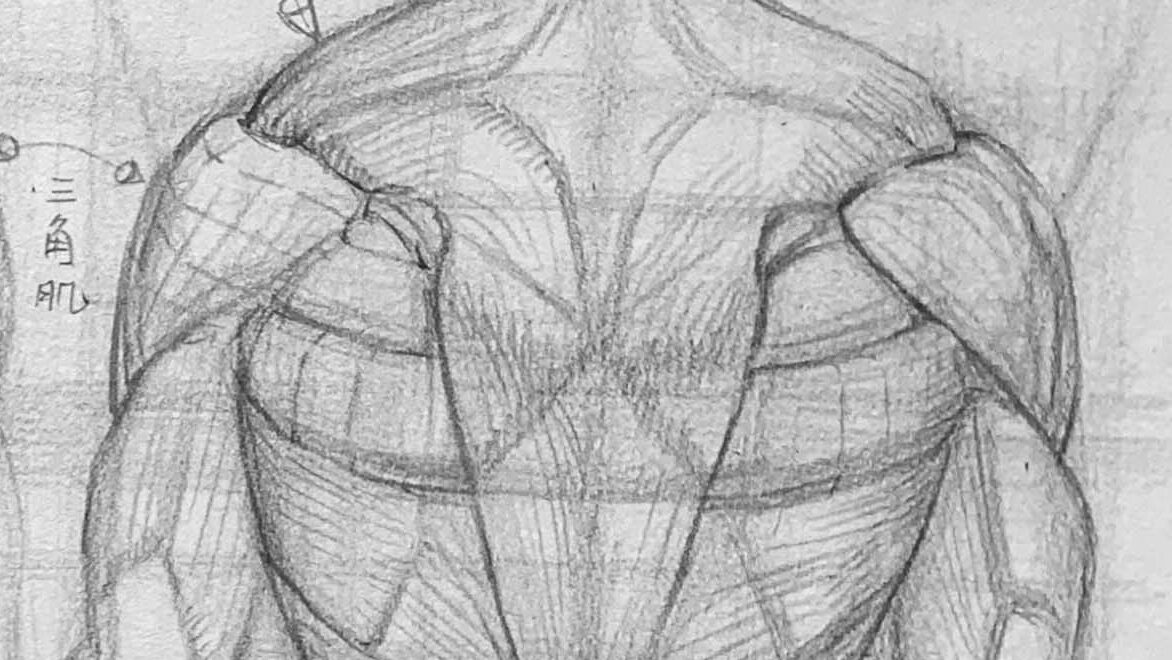
The deltoid is divided into three parts: anterior, middle, and posterior heads
- Anterior head: Originates from the front outer section of the clavicle and controls arm flexion (lifting forward).
- Middle head: Originates from the outer side of the acromion and is responsible for arm abduction (lifting sideways).
- Posterior head: Originates from the spine of the scapula and helps with extending the arm backward.

Upper Arm (Biceps Group and Related Muscles):
The muscles of the upper arm are generally divided into:Flexors on the front (biceps brachii and brachialis).Extensors on the back (triceps brachii).The appearance of these muscles changes noticeably with arm movements like bending or extending the elbow.
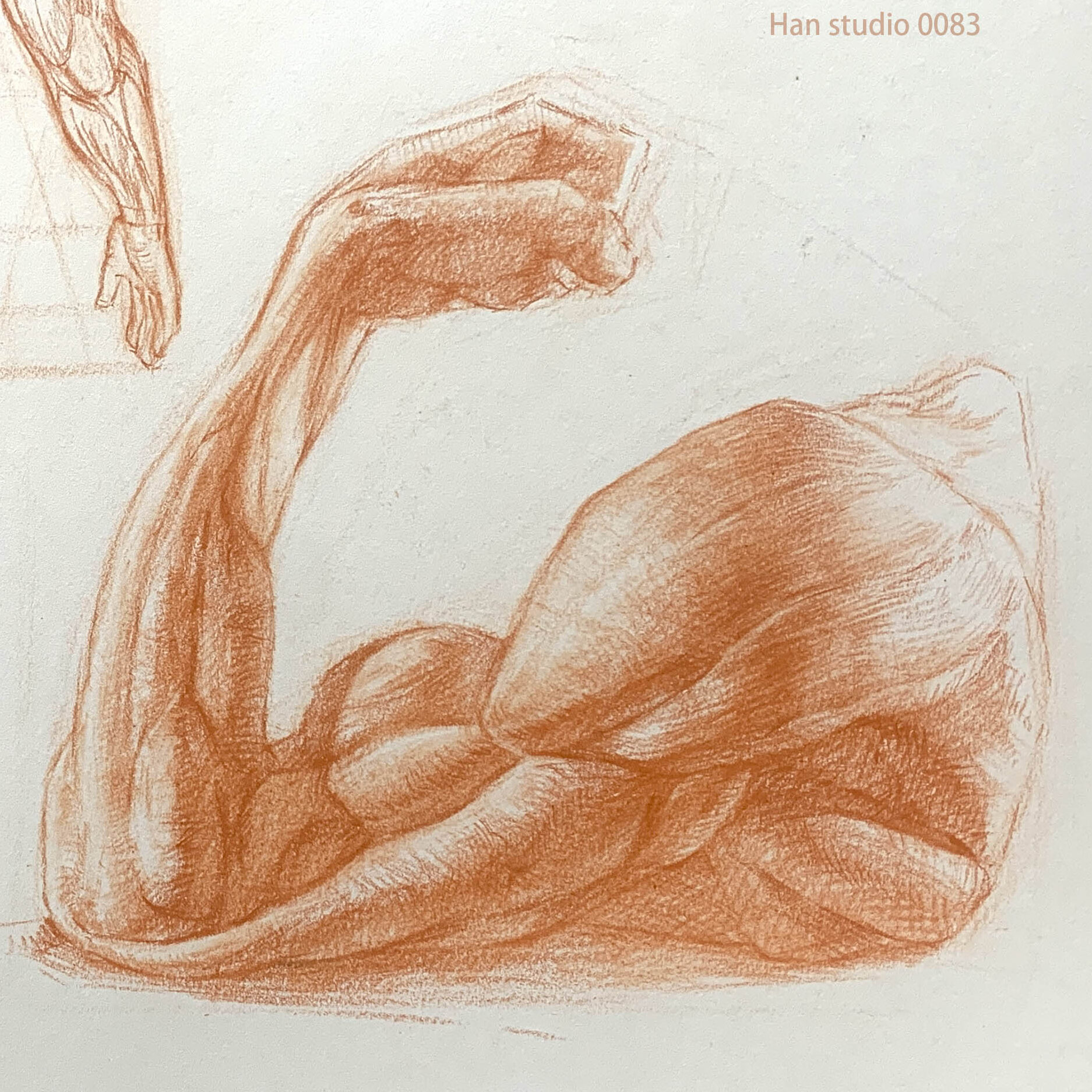

Brachialis:
Location and shape:
- Located beneath the biceps brachii, it extends from the mid-humerus to the ulnar tuberosity.It is one of the primary muscles responsible for forearm flexion.
- It appears flatter and shows a subtle contour beneath the biceps brachii.
視覺CharacteristicsCharacteristics
- Especially in side views of the upper arm, the contour of the brachialis slightly protrudes along the edge of the biceps.
- Origin: Middle to lower front section of the humerus
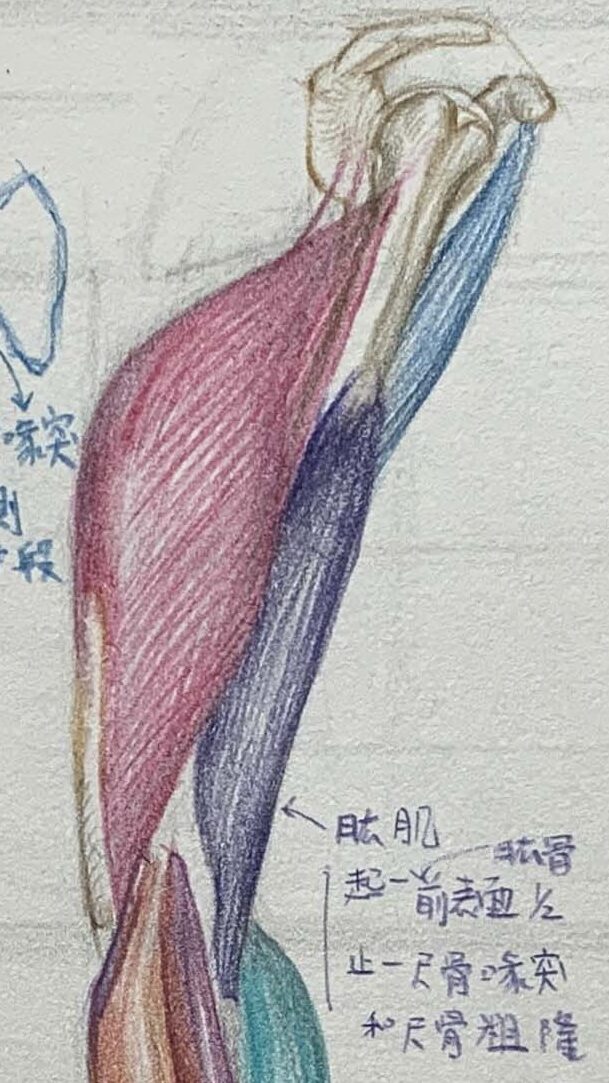
- Diagram note: The brachialis is shown in purple-blue, positioned between the biceps (blue-green) and triceps (pink-red).
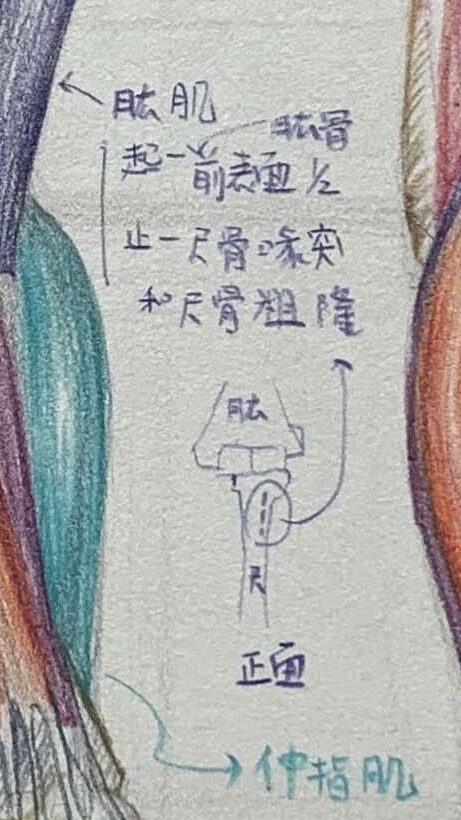
- Diagram note: The brachialis is shown in purple-blue, positioned between the biceps (blue-green) and triceps (pink-red).
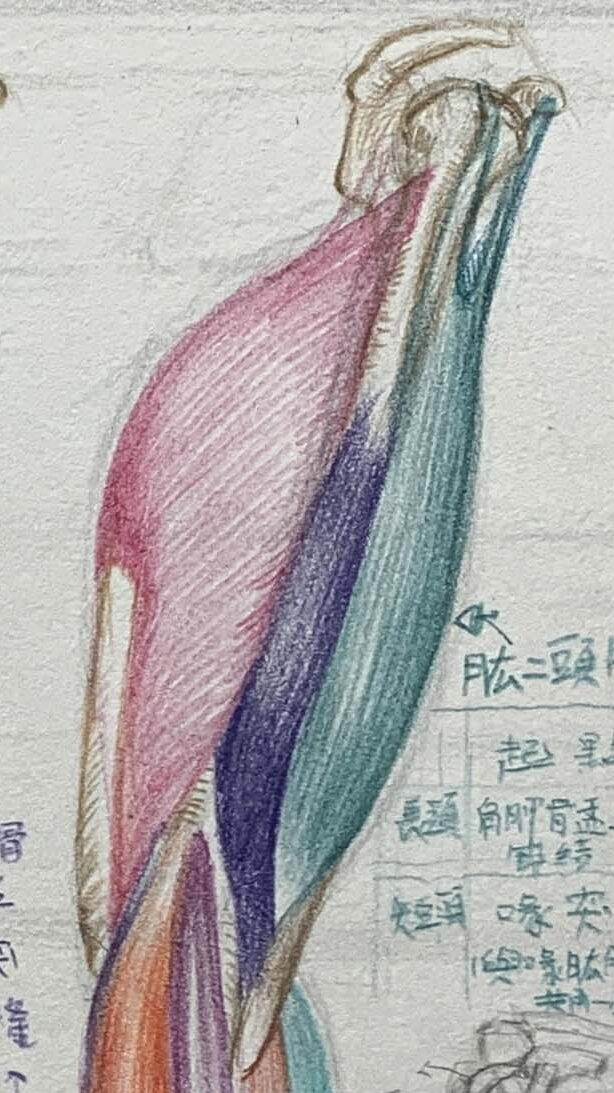
Biceps Brachii – Position and Shape:
- This is the most prominent muscle when the forearm is flexed, forming a full, oval shape.
- The biceps has two heads—long head and short head—originating from different points on the scapula, giving it a characteristic “two-headed” form. Both heads insert into the radial tuberosity (on the outer side, just below the elbow).

Long Head of the Biceps:
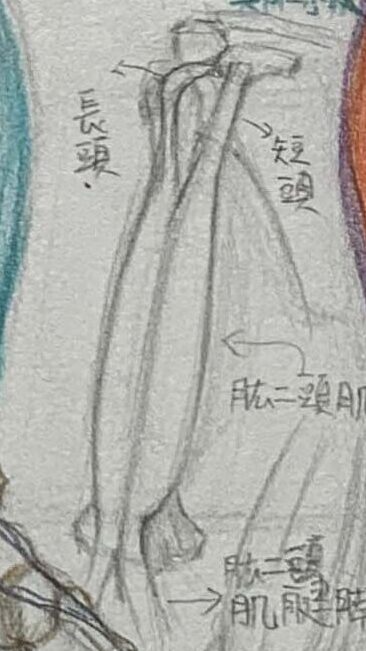
- Origin (long head): Supraglenoid tubercle of the scapula
- Insertion: Radial tuberosity and the bicipital aponeurosis
- Diagram note: The reddish-pink fatty-looking mass represents the long head, which is the most visible and located on the outer side.
Short Head of the Biceps:
- Origin: Coracoid process, a small curved projection on the front of the scapula
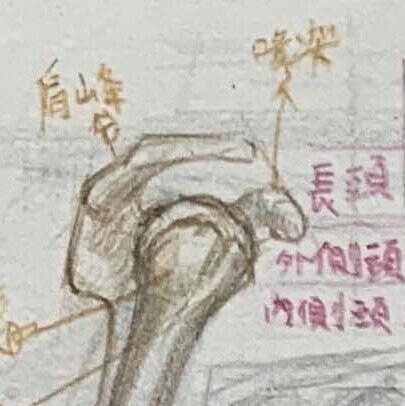
- Insertion: Same as the long head—radial tuberosity, merging into the same muscle belly

- Diagram note: The blue-green biceps sits above the purple-blue brachialis.

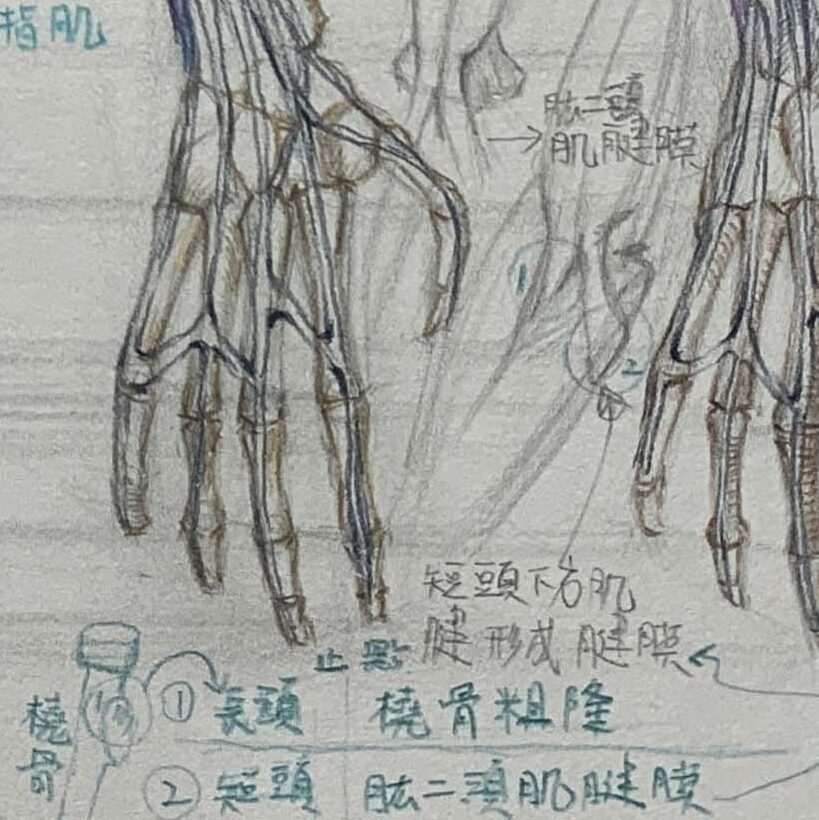
- Biceps Brachii: Located on the front of the arm. It becomes especially noticeable when you bend your arm.
- Triceps Brachii: Located on the back of the arm. It is responsible for straightening the arm.
- Forearm Muscles: These allow the arm to rotate and move with greater flexibility.
Triceps Brachii Group (Back of the Upper Arm – Pink Area):
Location and shape:
- Located on the back of the arm, this is the largest muscle group in the upper arm’s posterior side.
- It consists of three heads (long, lateral, and medial), with a long and wide shape. It is responsible for arm extension.
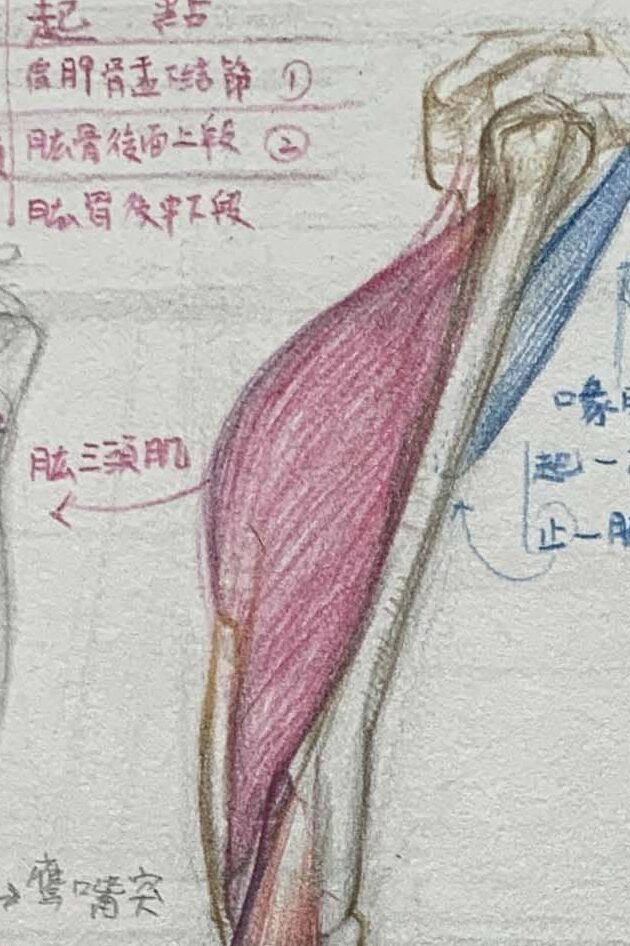
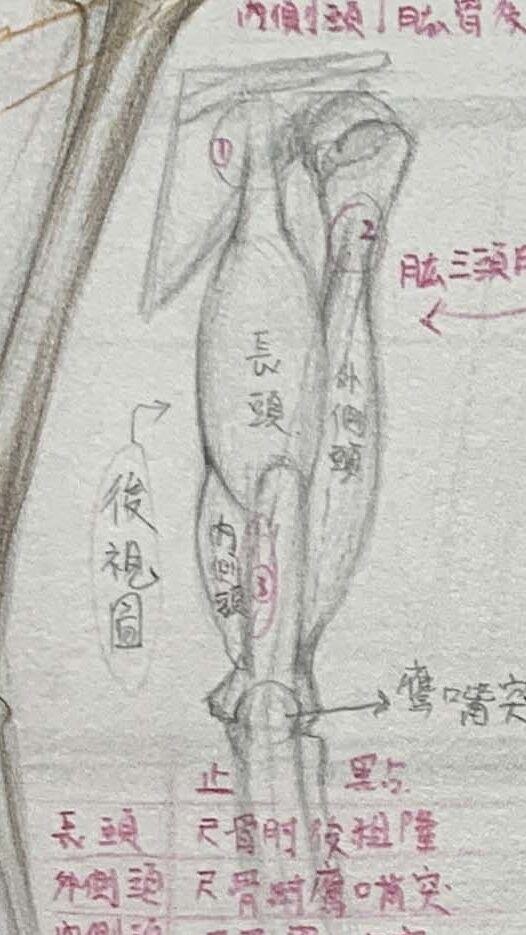
Key visual feature:
- When the arm is straight, the triceps are relaxed;when forcefully extended or supporting weight, the muscle tightens visibly, forming a distinct muscular contour.
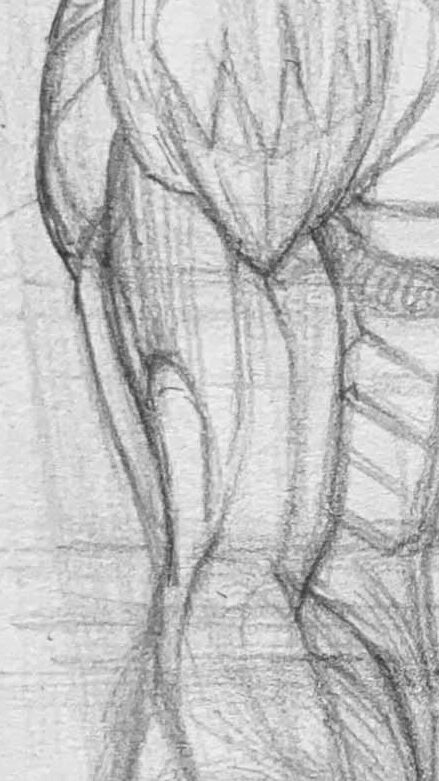
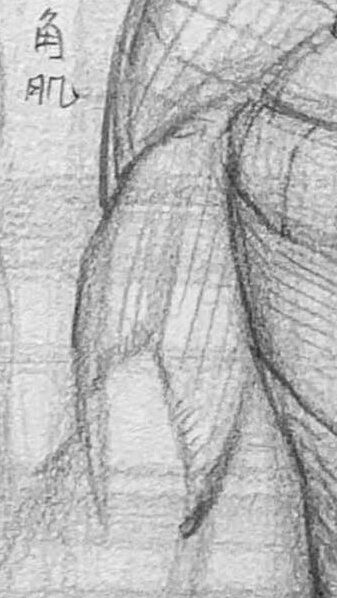
Triceps Long Head:
- Origin: Infraglenoid tubercle of the scapula
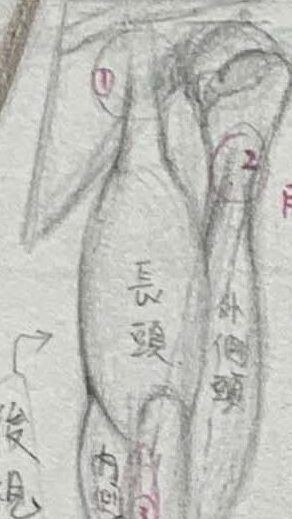
- Insertion: Olecranon of the ulna (elbow extensor area)
- Diagram: Light green area, extending from the back of the scapula to the elbow
Lateral and Medial Heads of the Triceps:
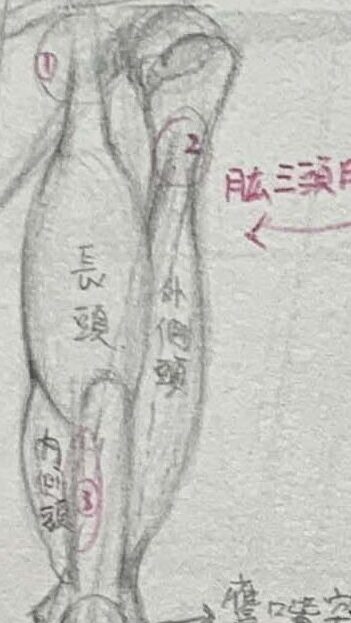
- Origin: Posterolateral and posteromedial surfaces of the humerus
- Insertion: Common extensor tendon at the elbow
- Diagram: Darker green, flanking the long head on both sides
Function: Extends the elbow and pushes the arm backward
Forearm Muscles (corresponding to the radius and ulna region)
Description:
The muscles of the forearm appear slender and densely packed. They control fine movements of the fingers and wrist. These muscles.gradually transition into long tendons as they extend from the elbow, visually forming a radiating pattern.
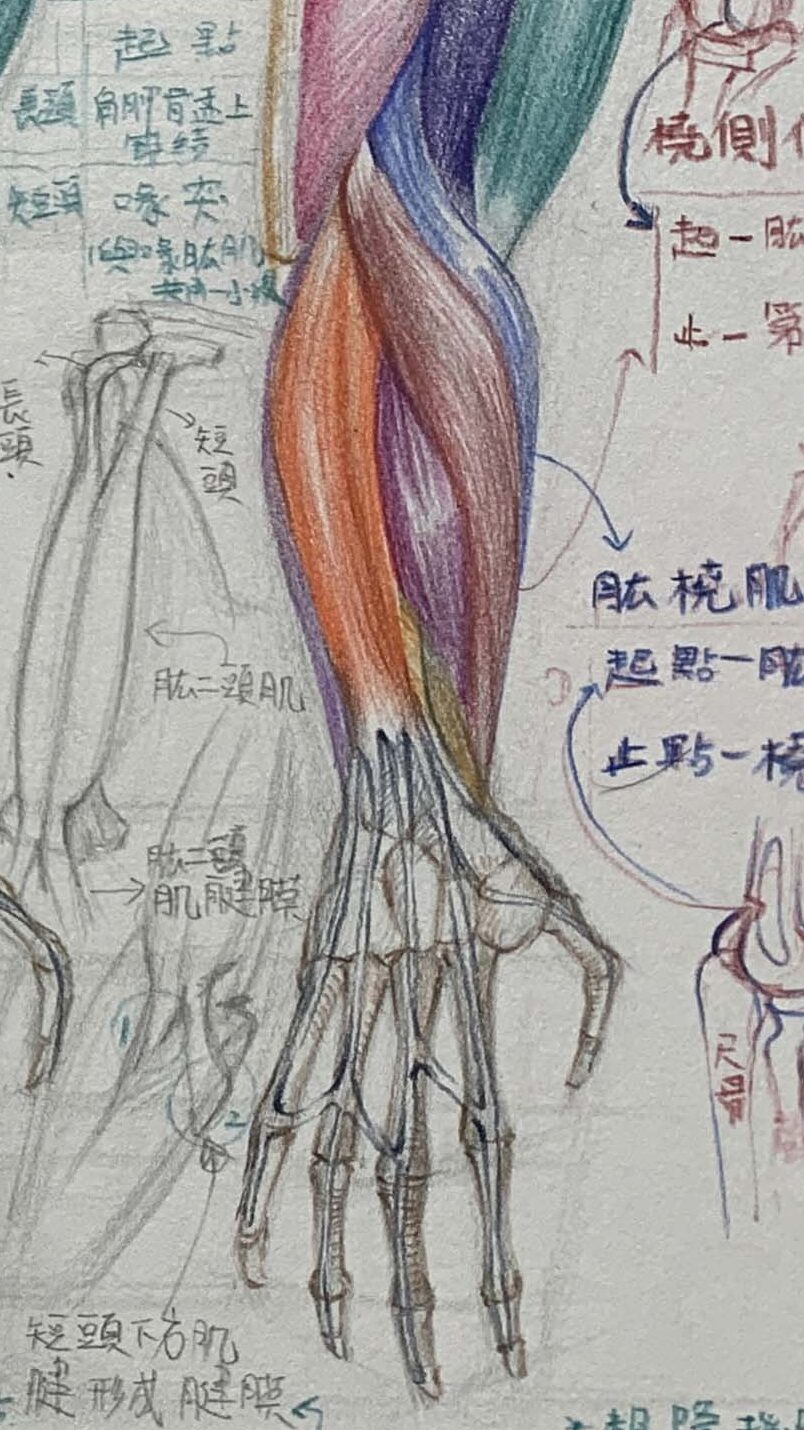
Brachioradialis (light blue):
- Origin: Lateral supracondylar ridge of the humerus
- Insertion: Styloid process of the radius
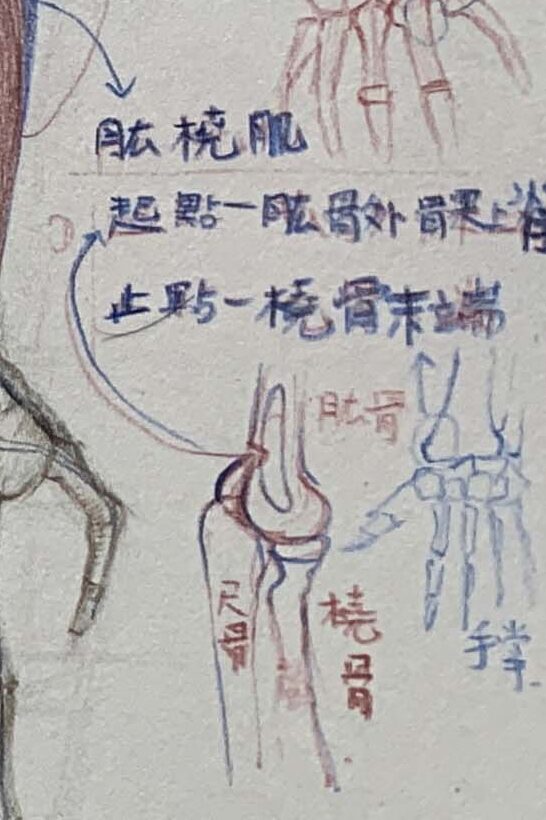
- Diagram: Light blue elongated strip along the outer edge of the forearm
- Function: Assists with forearm rotation from a flexed to neutral position, with a slight flexion role
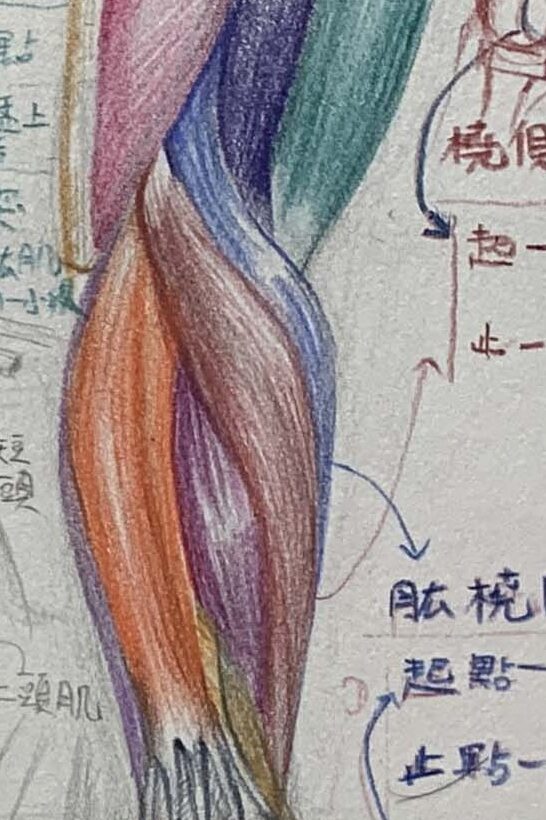
Wrist Extensor Group / Posterior Forearm (Dorsal) Extensors.Extensor Digitorum
Extensor Digitorum is a superficial, fan-shaped muscle located on the back of the forearm. It extends from the elbow to the back of the hand and splits into four tendons that control the extension of the 2nd to 5th fingers.
- Origin: Shares a common extensor tendon with other superficial extensors (e.g., extensor digiti minimi, extensor carpi ulnaris), attached to the lateral epicondyle of the humerus
- Insertion: Divides into four tendinous slips at the wrist, travels over the back of the hand, and merges into the extensor aponeurosis on the dorsal side of each finger
- Diagram: Thin, reddish-orange iris-shaped area extending from the elbow to the metacarpals, showing tendon directions
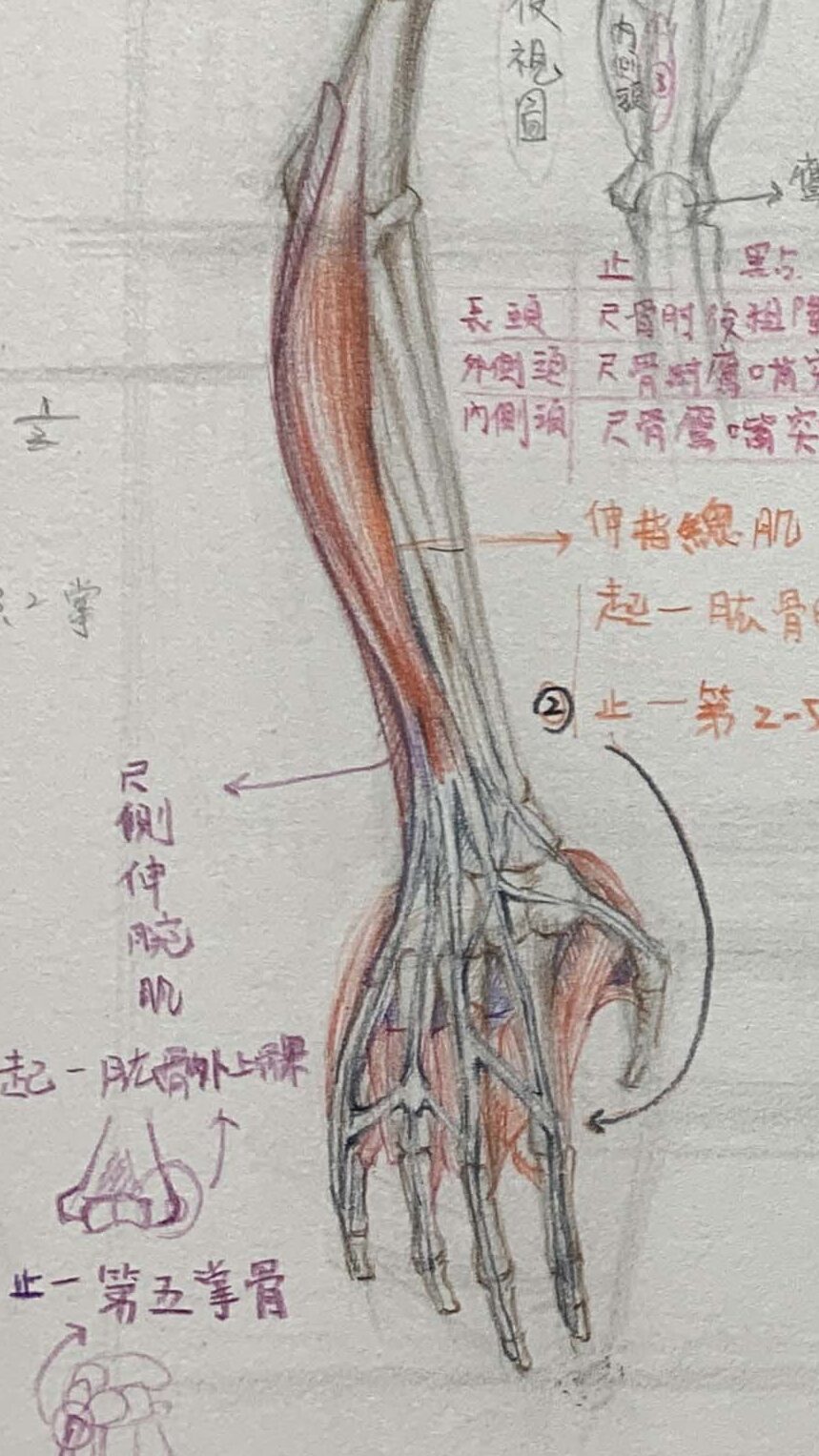
Palmaris Longus / Wrist Flexor Group:
Diagram: Thin, reddish-orange iris-shaped area extending from the elbow to the metacarpals, showing tendon directions
Origin: Mostly from the medial epicondyle of the humerus
Insertion: Tendons to the wrist and palm (palmar aponeurosis), 2nd to 5th metacarpals
Analysis of Arm Bones and Muscles
Bone Landmarks + Simplified Skeleton
- Right image: Brown lines mark the direction of the scapula and humerus from the side view; reference the left image for the anterior-posterior relationship of the ulna and radius.
- The purpose of drawing the bones is to understand that "bones are the foundation for muscle attachment." Skipping the bones and drawing only muscles may lead to incorrect placement.
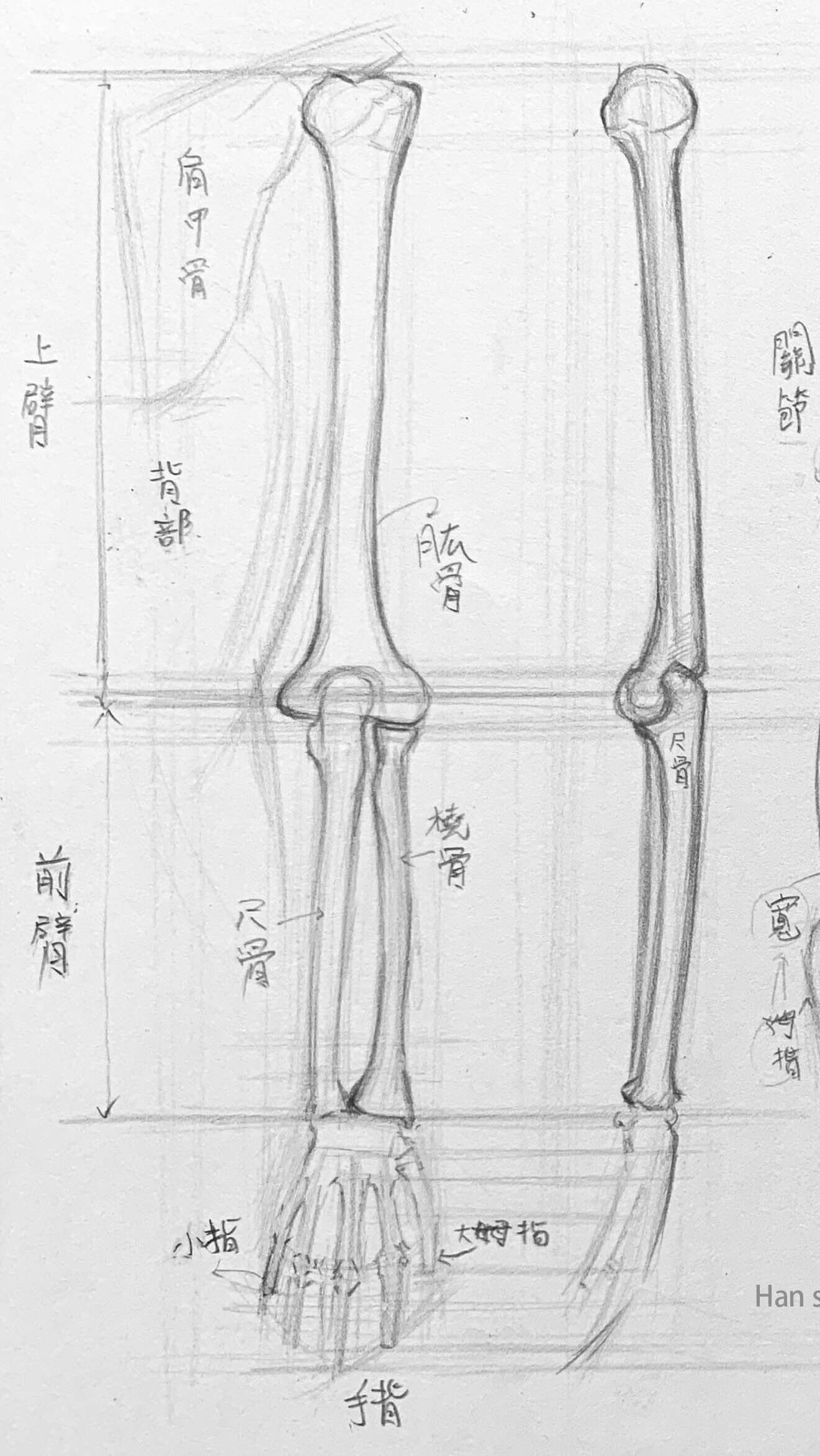
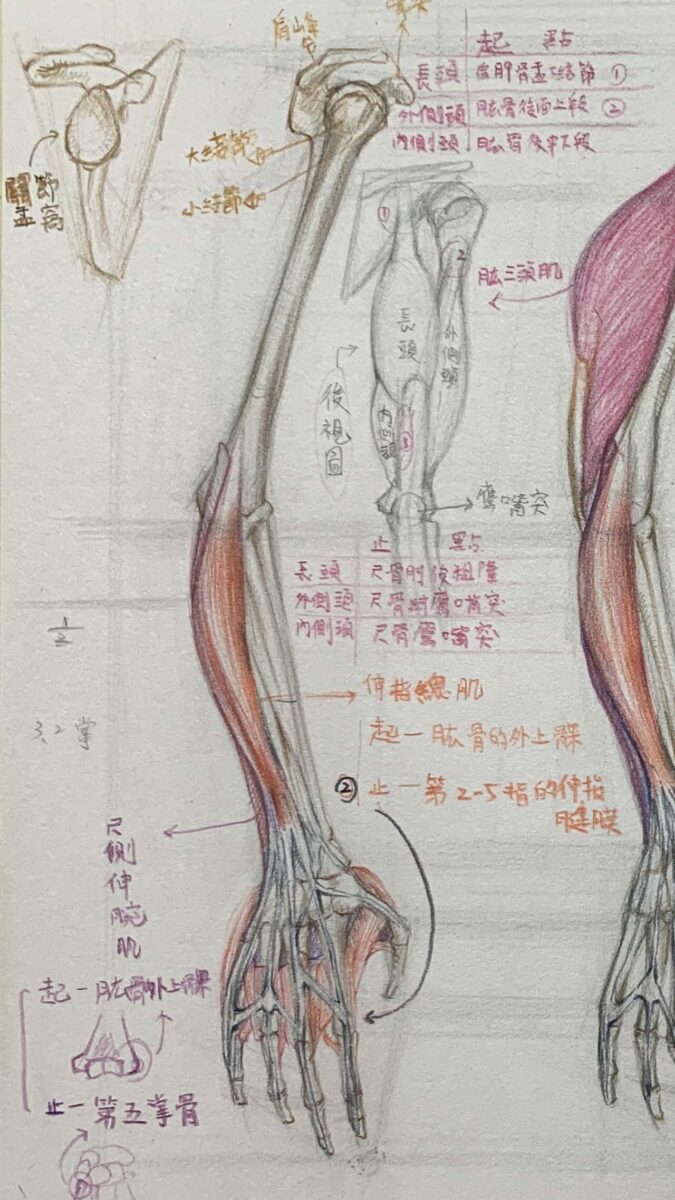
How to Draw the Arm?
Geometric Simplification of the Arm
Once you've understood the skeletal and muscular system, simplify the arm before rendering detailed muscle structure.
Think of the arm as being made of basic forms:
- The upper arm can be represented by a cylinder, which helps capture its basic form

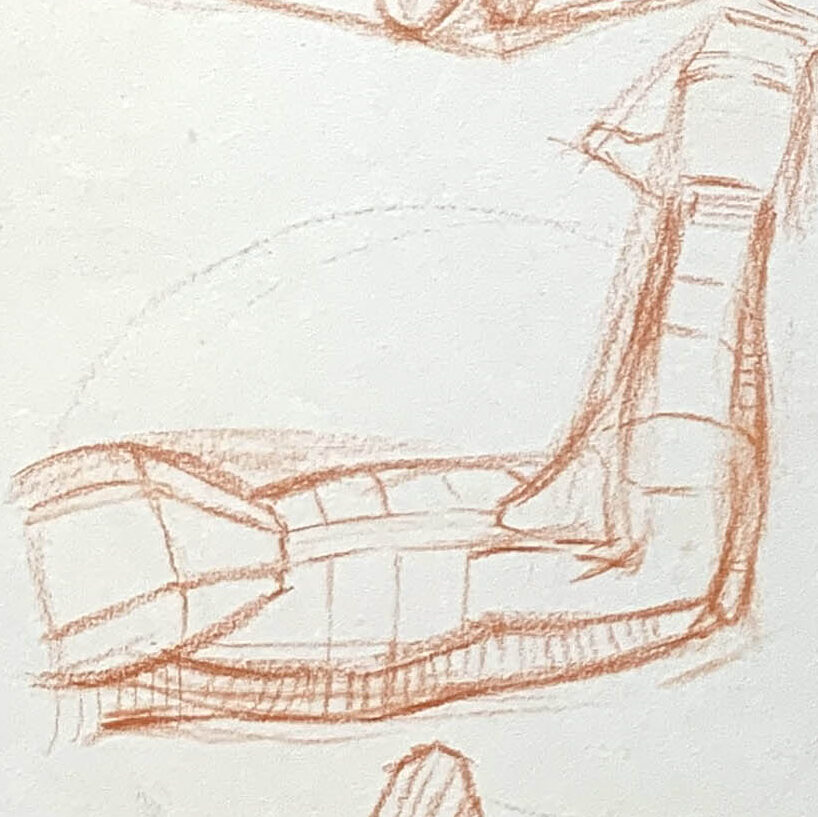
- The forearm is also a cylinder, but slightly narrower as it tapers toward the wrist
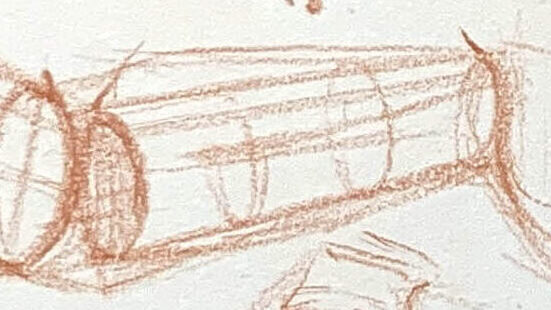
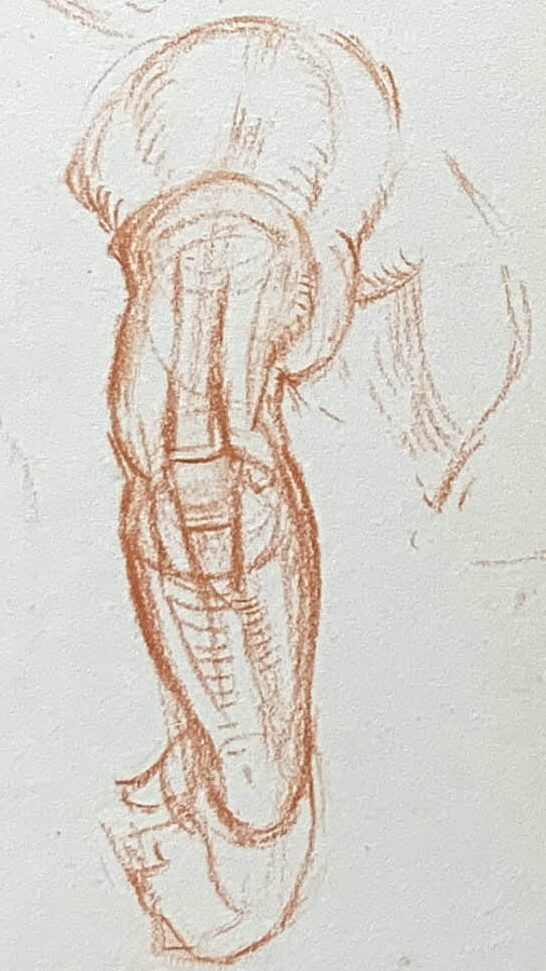
- The elbow joint can be visualized as a circle, connecting the upper and lower cylinders

Understanding Arm Proportions
Knowing the correct proportions helps you draw more natural-looking poses. Here are a few key tips:
- The upper arm is usually slightly longer than the forearm; for example, if the upper arm is 1 unit, the forearm might be about 0.8
- Anatomically, the elbow is not exactly at the midpoint of the arm



How to locate the elbow joint through observation?
- Step 1: Draw a vertical line from the acromion (shoulder tip) to the wrist
- Divide this line into 5 equal parts. The upper 3/5 indicates the approximate length from shoulder to elbow
- the lower 2/5 from elbow to wrist. So, the elbow roughly sits at the "3/5 mark" of the total arm length
Common Challenges When Drawing Arms and Suggested Solutions
Confusing Muscle Origins and Insertions
- Example: Students often remember the muscle as one long form, without knowing whether it runs from the scapula to the ulna—or the reverse
- Solution::
- Use color-coded arrows: thick arrows (e.g., red) for origins, thin arrows (e.g., purple) for insertions
- Draw two small diagrams on a blank page, one showing origin, one showing insertion, with notes like: “When bending the elbow, this muscle from the scapula to the radius contracts.”
Not Understanding Muscle Layering (Which is on the surface, which is underneath)
- Example: Laying out all muscles flat makes the drawing look 2D and unclear in depth, especially with forearm muscles
- Solution::
- Start by sketching the outer contour, drawing the most superficial muscles first (deltoid, biceps, triceps).Then draw the underlying layers (brachialis, brachioradialis, flexor/extensor groups)
- Use light pencil (2H or HB) for inner muscles and darker pencil for outlining the outer layers to emphasize depth
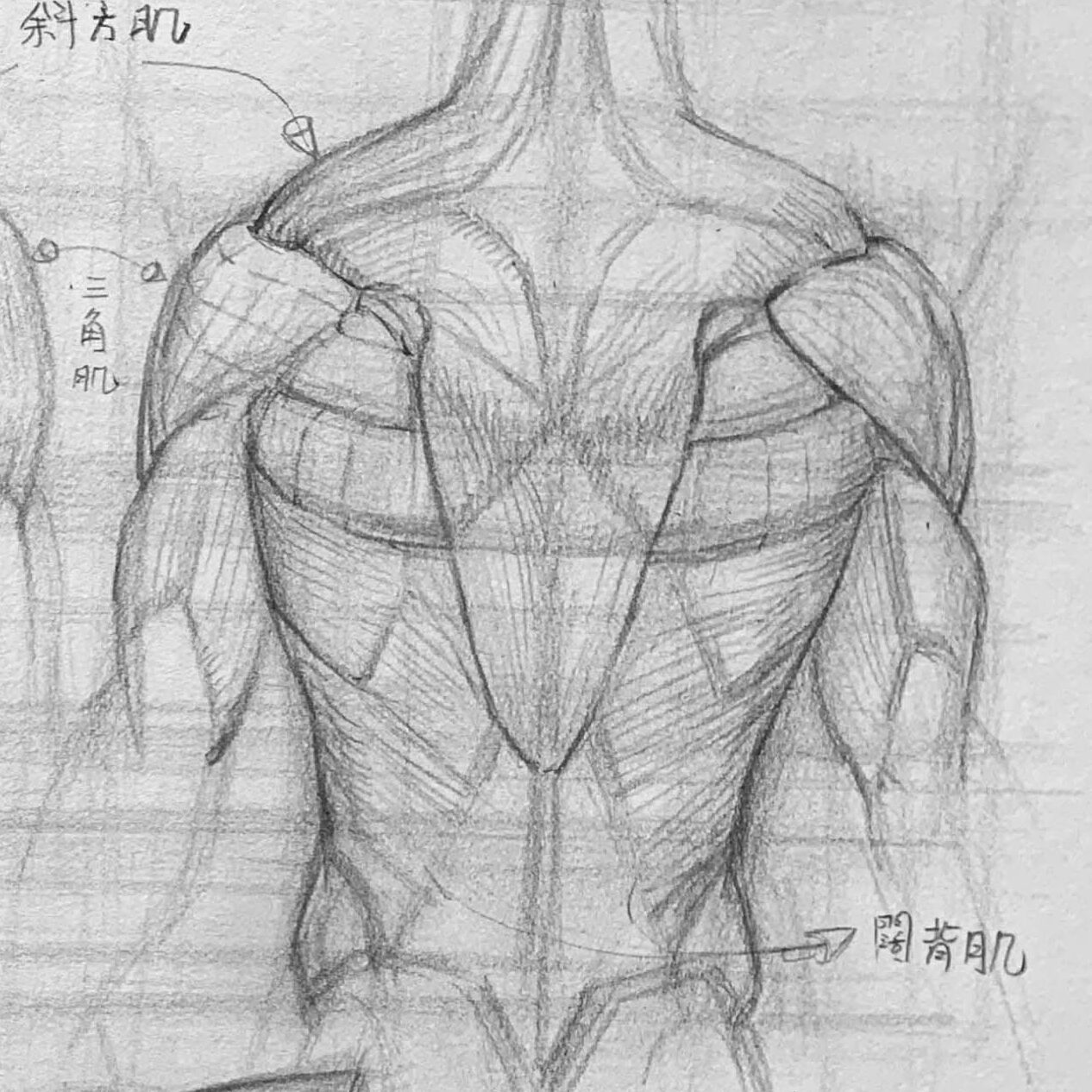
Difficulty Capturing the Transition from "Wide → Narrow → Tendon"
- Common mistake: Drawing a muscle equally thick from end to end, or dragging it too long or wide into the wrist area
- Solution::
- Demonstrate how a muscle transitions from the thick belly → into thin tendon → and finally attaches to the bone
Summary: How to Draw the Arm
This lesson covered three key steps:
1.Understand the major bones of the arm, including how the upper and lower arm move and change shape when rotated
2.Learn the muscle groups and how they wrap around the skeleton. 3.Simplify the arm into basic forms and grasp overall proportions
For beginners, the most important thing is to keep it simple—don’t worry about every tiny detail at first. Focus on understanding the basic shapes and proportions so you can gradually build your structural awareness.
Challenge:
Draw an arm starting with simple geometric shapes, then add muscle detail and shading. If you can draw arms naturally from multiple angles, that means you've gained a solid foundation in arm structure and proportion!
- Key Concepts Overview:
- The diagrams include fundamental 3D structures of the arm, using cylinders to represent form. These help us understand the basic shape and proportion relationships.The upper and lower arm can both be visualized as cylinders
- The elbow functions as a joint connecting these two cylinders
- Key Concepts Overview:
- Start by drawing simplified cylinders to represent the upper and lower arm. Don’t worry about muscles yet—just get the proportion and perspective of the cylinders right.
- Try drawing the arm in various positions, such as extended and bent, to better understand how to adjust length and angle to reflect movement.
Among these arm bone structures, which part do you find the hardest to draw? Let me know in the comments! 👋
If you're interested in learning to draw but don't know where to start, or if you'd like to understand the knowledge behind drawing,
feel free to join my LINE and contact me. In my classes, I organize drawing methods in a clear and structured way.
Click here to learn more about my drawing courses!
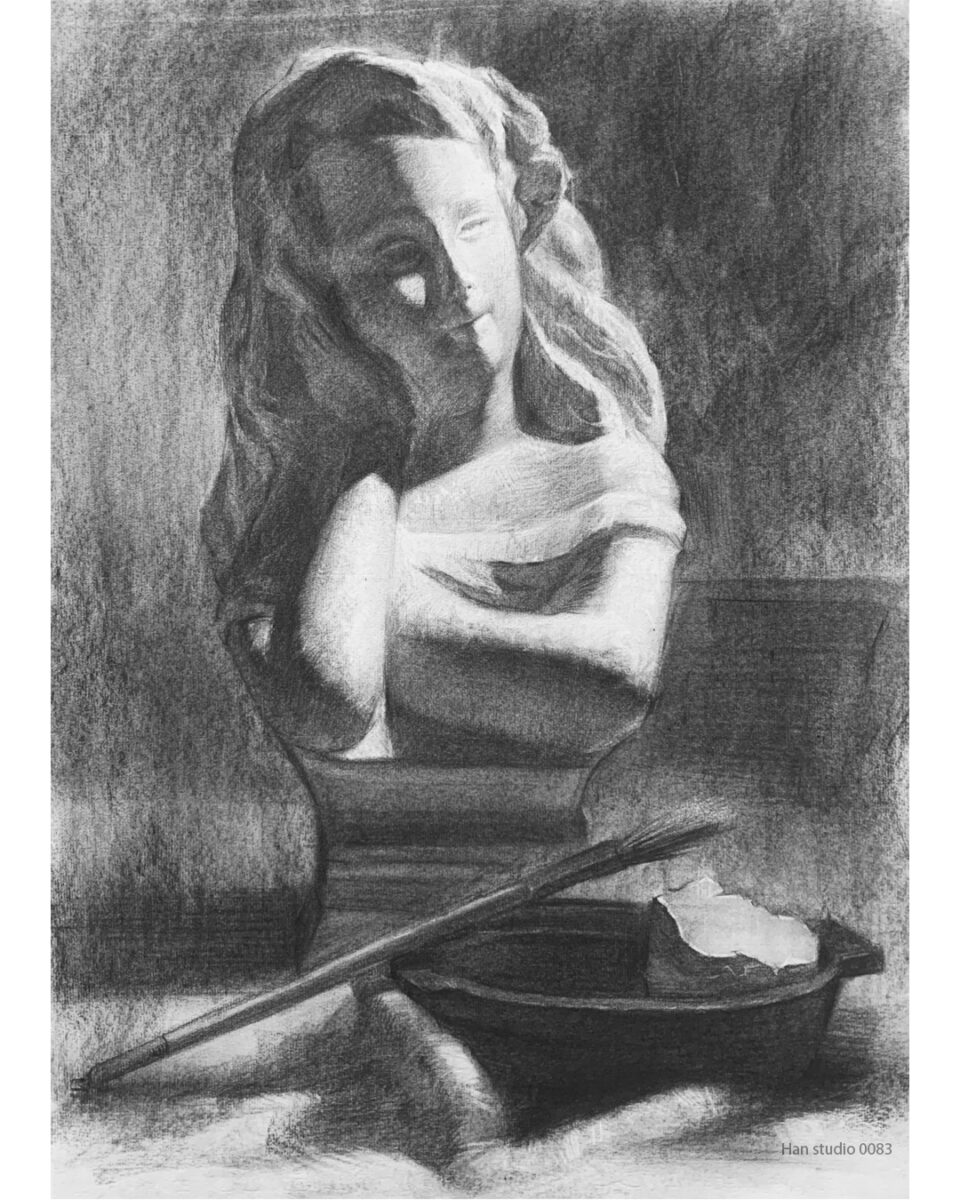
Want to explore more articles on extended drawing techniques?
How to Accurately Master Hand Proportions and Joint Structure
How to Draw Ears:Simplified Ear Structure and Shading Tips
How to Use Two-Tone Shading: Simple Shadow Techniques
How to Sketch Facial Muscles: Capture Realism and Expression
How to Draw Masks: Use Perspective and Shadows
Building Up from Simple Contours to Detailed Eye Portraits
Capturing Realism in Lip Drawing: Key Structures and Shading
Understanding the Three Key Elements of Head Structure
Mastering the basic proportions and structure of portrait drawing
